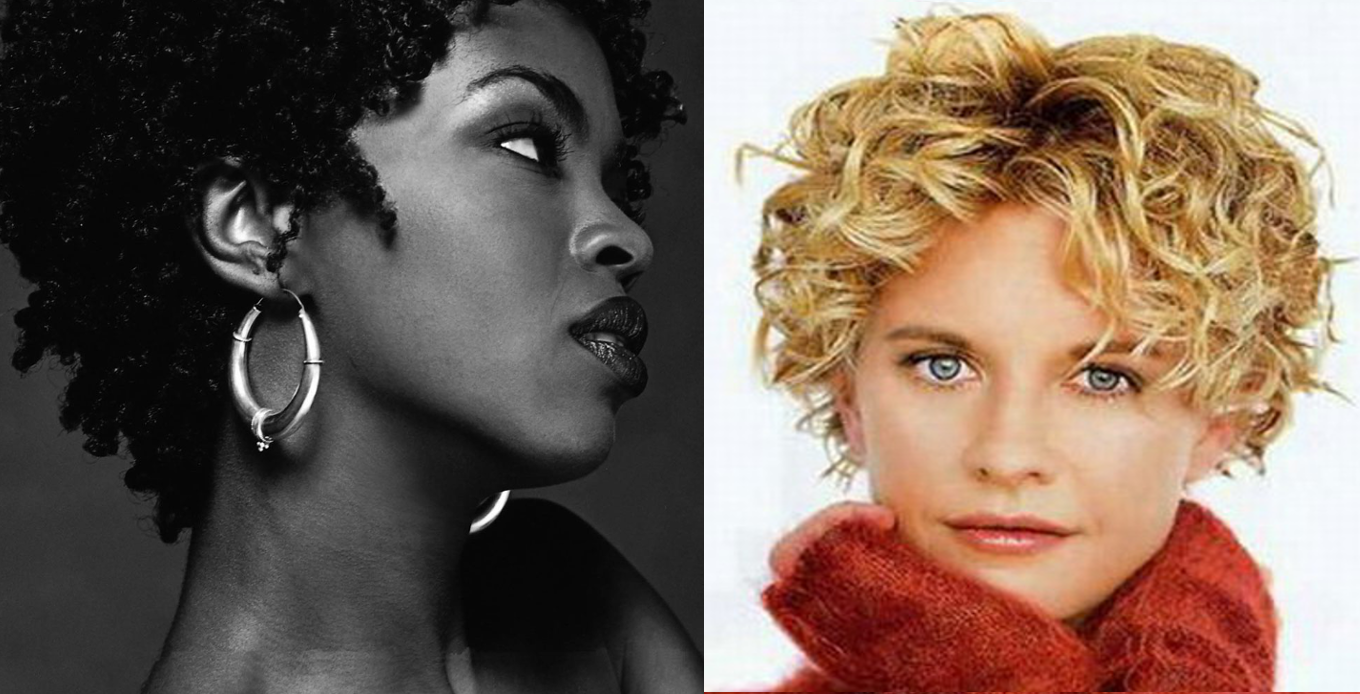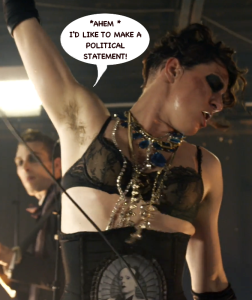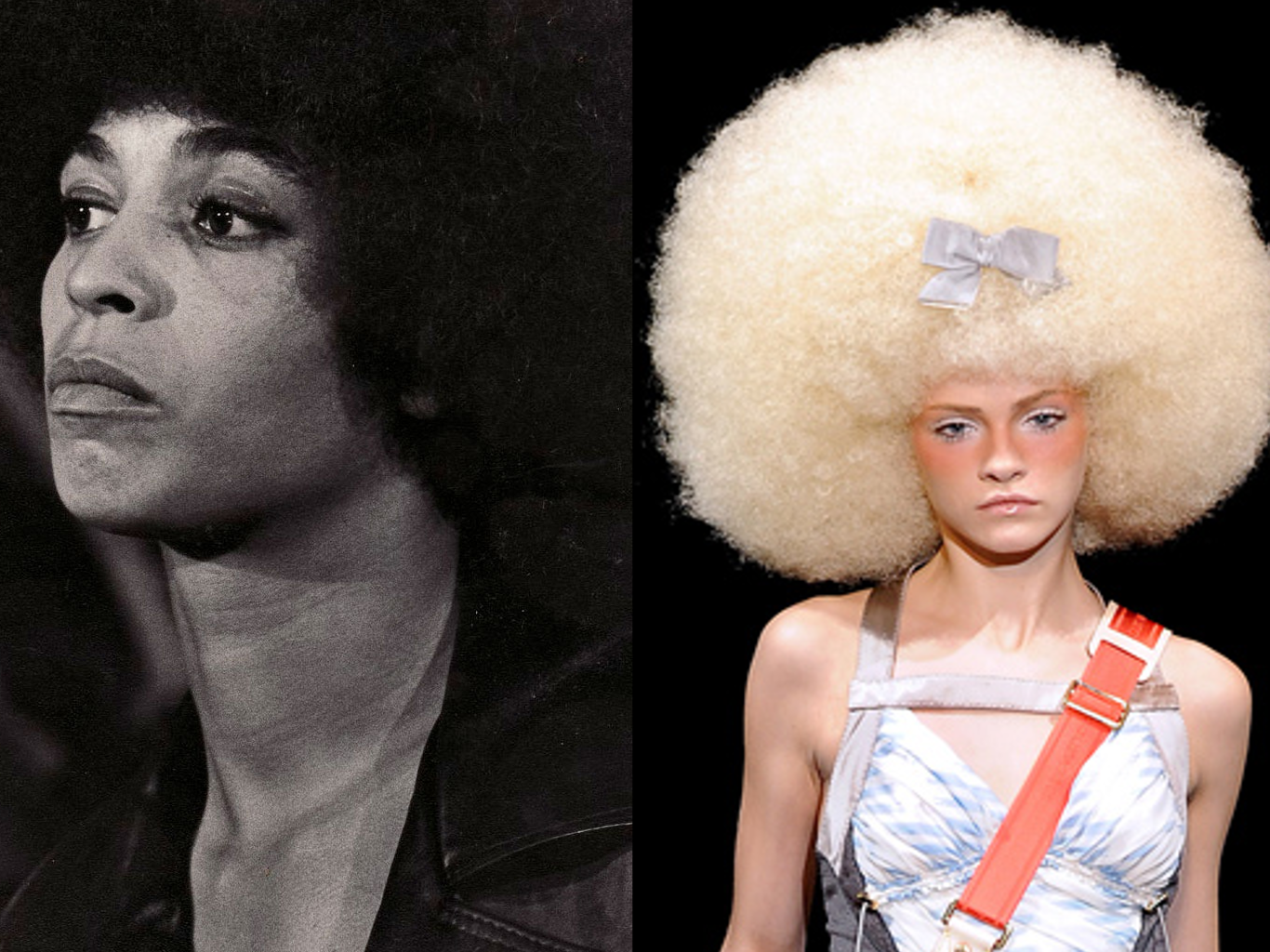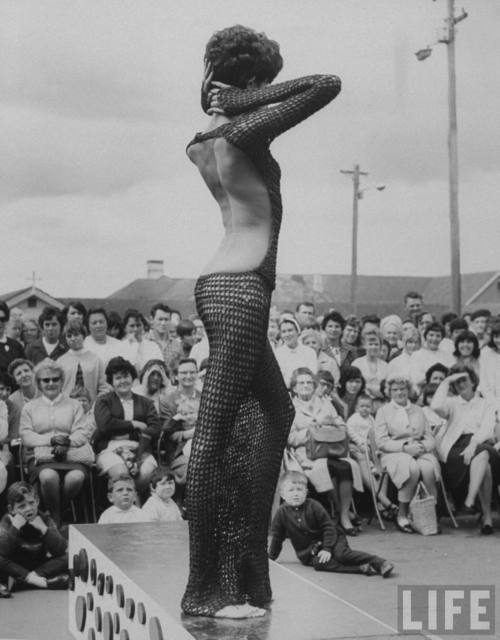
Hair is political
“Hair is political” has become a commonplace statement in black feminist circles. I don’t know that Chimamanda Ngozi Adichie is responsible for popularizing the phrase, but she certainly seems to be the person saying it most often these days. The first time I can recall hearing someone discuss the racial-cum-gender politics of hair was at the 2011 Annual Women’s Studies Conference in Pensacola, Florida. The speaker, Aphrodite Kocieda, described the straightening and lengthening of hair—and white mimicry in general—as a tool black women use to obtain visibility in a “racist, sexist, patriarchal society.”
That was a long time ago, but all this talk about racist hair and political hair lately has me wondering: What about white folk’s hair? If the straightening of black hair represents racial sublimation and an attempt to conform to other groups’ standards of beauty, then what does the curling and perming of European/white hair signify?
Googling didn’t turn up anything. Perhaps white women/men altering their hair in damaging ways is not a contentious subject (though I suspect Sheila Jeffreys would disagree). Perhaps Google is not the best tool for finding articles on the subject of hair politics. Whatever the case, I didn’t find much, but I did find enough to formulate a hypothesis.

Sidenote: Hair grows all over our bodies. It’s on our faces, our nipples, our backs, our fingers and toes, our legs. It invades our arm pits, our pelvises, our asses. It’s even in our ears. Racial, class and gender norms surround what we do with much of it; but, for the purposes of this discussion, I’m only going to discuss the hair on our heads. I will save Amanda Palmer’s armpits and Sasha Grey’s vulva for another day (far, far away).
Racist hair
I found an interesting November 2010 news article, authored by West Palm Beach’s Channel 5 news anchor Rochelle Ritchie, on the decision to “go natural.” Ritchie describes how, fresh out of college and after sending out dozens of resumes and video samples, she was unable to get a news job. Eventually, a black newswoman took pity on her and told her that she needed hair extensions if she wanted a job (supporting Aphrodite’s point about the invisibility of black women and making me ponder Jessica Williams’ long locks). Ritchie says she immediately began getting calls.
Unfortunately, Ritchie herself is not all that impressive. Her stated reason for going natural is cosmetic–to prevent further hair damage and loss–and her article (and news bit) on the subject steers clear of race and gender issues. Ritchie’s faltering speech when discussing her hair with white colleagues (“I feel just as professional, intelligent, as artic- inar- articulate—Look! I can’t even talk now!—as I did when I had the extensions and the wigs.”) reminds me of Claude Steele’s explanation of stereotype vulnerability: that a person’s performance tends to falter if they feel it’s to be taken as a direct reflection of their group. One of the women Ritchie’s news special featured had a more conscientious and concrete motivation: She did it for her daughter.
Joe-Hannah Louisma says she had straight hair for most of her life. She decided to go natural when she saw the bullying her young daughter endured at school for having “nappy” hair. She had her head shaved and let her natural hair grow to foster a sense of solidarity between her daughter and herself and to help her daughter realize that she did not need to mold herself to other’s standards of beauty to be beautiful.
Hair as cordon sanitaire
As far as socially conscious discussions of hair not directly related to black women go, all I can find are some blog posts. Blogger digby, of the blog Hullabaloo, in her May 5, 2007, blog entry “Tarzan, Jane and Cheetah”, (about homophobia and the far right) briefly mentions the “shrieking aversion to the dirty hippie…‘feminine’ hair on men’s heads and ‘masculine’ hair on women’s bodies” as an expression of “gender role anxiety” that has become “a political narrative that continues to powerfully affect politics today.” In January of 2010, blogger Alex Blaze, of The BILERICO Project, affirmed digby’s sentiment:
“Hair is still political, especially since it’s malleable enough to be a form of self-expression, attached to one’s own body to make it incredibly personal, is laden with cultural, racial, gender, and religious politics, and grows back and can be changed fast enough to make it a moral decision worthy of condemnation.”
Blaze sees attempts to dictate people’s hairstyle preferences as “trying to show people who’s boss and that even their identity that’s a natural part of their bodies can be surveilled, policed, and changed by someone more powerful.”
I only found one blogger who specifically dealt with the subject of white women with “black” hairstyles. An August 2009 blog entry by pop culture critic Thembi Ford reads: “And these white women born with straightforward wash n’ go hair just chop all of that white privilege off and throw away what black women pay good money for at the hair store? It’s just not right.” Ford, who herself sports a “natural,” explains, “I didn’t read Wuthering Heights and watch Thorn Birds without learning something—long hair is the stuff of romance. Short hair can be sexy but it’s not for everyone…” She goes on to profess a desire to shave her head and concludes by admonishing people to wear “ethnically appropriate” hairstyles.
Nicole J. Butler, commenting on Ford’s post, took a more egalitarian stance, explaining that black women who straighten their hair are attempting “to be accepted by the ‘majority’ culture” and are acting not “out of desire, but out of fear.” She continues by saying that black women should appreciate white women who cross cultural boundaries to emulate them, asserting, “They get my applause as do black women who refuse to flatten their hair into submission.” Butler, while acknowledging that white women do enjoy white privilege, reminds readers that “this is still a patriarchal society,” and advocates solidarity over infighting among women.

Afrocentric beauty through a racist lens
Despite the paucity of commentary combining both race and gender concerns regarding white people who choose to perm their hair, I have developed a hypothesis. Kocieda mentions that on those rare occasions when the media present black women sporting their natural hair it is often in a prurient and exploitative context. In “Screening the Body,” Lisa Cartwright asserts that, since at least the Enlightenment, many of those engaged ostensibly in scientific enquiry have promoted typological systems furthering a “biologistic and empirical pathologizing of sexualized bodies [assigning] a ranked hierarchy of intelligence, health, and morality […] to categories of gender, race, and class.” In “Claiming Jezebel,” Ayana Byrd talks about the hypersexualization of black women as machinating to return them to the “slave era position of anonymous chattel.” She quotes bell hooks in identifying this practice as constructed to give the impression of an expendable commodity. Byrd mentions the Hottentot Venus as a particularly bizarre example of the exaggeration of black female sexuality that the dominant culture has attempted to perpetuate since at least the slave era if not longer.
Perhaps these white folk with their permed and dyed hair are attempting to imitate the exaggerated exotic and erotic stereotypes they associate with the black woman, with the Saartjie Baartmans, Pam Griers and Tamara Dobsons of white-male-gaze blaxploitation/slave-fetish lore. Many people get these perms for special occasions, attempting to attain just a little more allure. Proms, beauty pageants, Mardi Gras balls: all occasions for square and straight alike to try their damndest to be as sexy as possible. And how better than by emulating some archetypal dark goddess? Whether this speaks to a subconscious racism on the part of women (and men) who perm their hair or to the racism and sexism of the men (and women, and overall patriarchal culture) they aim to please is debatable. Probably both.

Beauty that inheres
I realize I haven’t presented much of an argument, but it is just plausible and at the very least a start. Sheila Jeffreys relates that “what is beautiful is constructed politically and incorporates race, class and sex prejudices.” Beauty and sexuality, as they inhere in the human body, are woven together by complex instinctual, psychological and cultural threads. Prejudice and desideration, reverence and lust, beauty, grotesquery, the coy and the brazen, all mingle and morph in the mind of the human animal and the eye of an increasingly over-stimulated and apathetic society. Standards of beauty punish black for not being white and white for not being black—“Il faut souffrir pour être belle,” we are chided—and each simultaneously spurns while emulating the other. The forces that compel us are as incapable of healing our wounds as they are of feeling them, and we are as incapable of seeing our own beauty and worth as we are of acknowledging the beauty and worth of those we perceive as ‘other.’